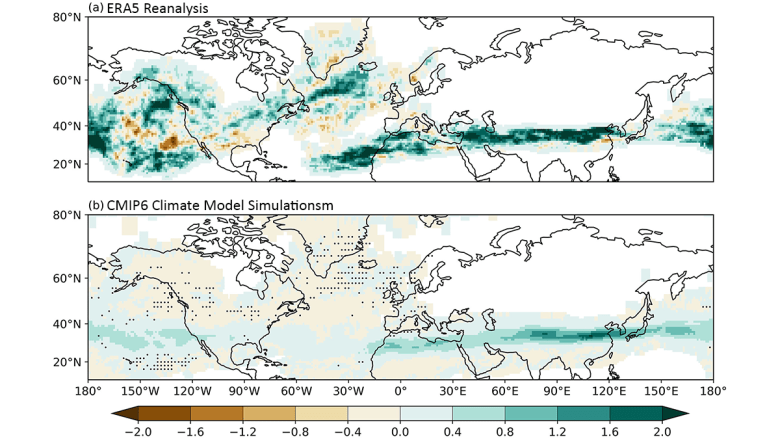
Editors’ Highlights are summaries of recent papers by AGU’s journal editors.
Source: Journal of Geophysical Research: Atmospheres
Atmospheric turbulence is responsible for most weather-related aircraft accidents, and clear-air turbulence (CAT, distant from convection and mountain wave effects) is especially difficult to detect and avoid.
Foudad et al. [2024] evaluate past and future changes in CAT based on meteorological reanalysis and coupled climate model experiments. Calculations are based on statistics of upper-level jet shear zones (near the tropopause), which are mainly responsible for generation of CAT. Past changes derived from reanalysis data show positive trends in CAT occurrence during 1980-2021, linked to increases in upper-level jets, with largest changes over the Pacific and North Atlantic oceans, and from North Africa to East Asia (top panel of image above). Forced climate model simulations of the recent past show similar behavior (bottom panel of image), arguing for anthropogenic forcing for some of these changes. Climate projections from the models show continued CAT increases over the Northern Hemisphere in future warming climates.
Citation: Foudad, M., Sanchez-Gomez, E., Jaravel, T., Rochoux, M. C., & Terray, L. (2024). Past and future trends in clear-air turbulence over the northern hemisphere. Journal of Geophysical Research: Atmospheres, 129, e2023JD040261. https://doi.org/10.1029/2023JD040261
—William J. Randel, Editor, JGR: Atmospheres
Text © 2024. The authors. CC BY-NC-ND 3.0Except where otherwise noted, images are subject to copyright. Any reuse without express permission from the copyright owner is prohibited.
Related
